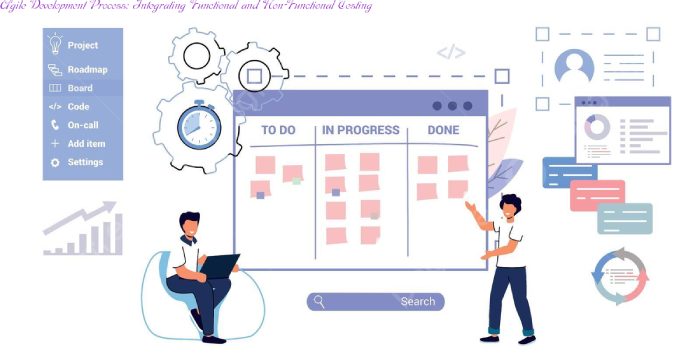Agile Development Process: Integrating Functional and Non-Functional Testing

Agile Development Process: Integrating Functional and Non-Functional Testing
Agile software development is proof of the effectiveness of iterative techniques. It supports a dynamic environment that values adaptability in the face of change, collaboration, and flexibility.
One of the many benefits of the Agile methodology is its capacity to speed up the delivery of operational software. The agile approach makes it necessary to incorporate testing as an integral part of the development process to achieve this.
Testing is a varied range of actions rather than a single process. Functional and non-functional testing are two essential elements within this vast spectrum. Software programs must work according to their design specifications and meet their pre-defined requirements; functional testing acts as a checkpoint to ensure this. Non-functional testing, on the other hand, focuses on the characteristics of the software that go beyond its primary functionality, such as performance, security, and usability. These two testing methods used within the Agile development process can significantly improve early problem detection and guarantee the delivery of high-quality software.
Table of Contents
Using Functional and Non-Functional Testing in Agile Development
Embrace testing as part of the definition of finished:
The ‘Definition of Done’ (DoD), a detailed list of actions that must be completed before a user story is deemed complete, is a notion introduced by the Agile approach. This checklist should cover both functional and non-functional testing. Including testing within the DoD guarantees that every programme component is thoroughly examined before making it available to the public.
Benefit from Automated Testing
Due to its capacity to speed up testing while maintaining effectiveness, it has become an essential tool in Agile development. Automated tests can be set up to run after every change to the code, ensuring quick issue discovery during the development cycle. To make this easier, many different tools have been created. For instance, Apache JMeter has become a widely used option for automating non-functional testing, whereas Selenium has become a popular alternative for automating functional testing.
Each sprint should incorporate testing:
Agile development divides work into distinct, time-limited units called sprints. A sprint typically lasts two to four weeks. Each sprint should include testing activities, including functional and non-functional testing, to ensure a continual software review. Using this strategy, testing transforms from an after-development phase to a regular activity that occurs throughout the development cycle.
Support cooperative testing:
The Agile methodology benefits greatly from cooperation. Accordingly, testing should be viewed as a team endeavour involving the entire group rather than just the testing experts. Functional testing should involve active participation from developers, but non-functional testing may require architects, security specialists, and usability specialists. It guarantees that the programme is examined from various angles, resulting in a more thorough evaluation. This is accomplished by promoting participation from various team members.
Implement metrics to monitor testing progress:
In agile development, metrics are essential for monitoring progress and identifying improvement areas. Testing progress should be tracked using metrics like the number of test cases executed, the number of defects found, and the percentage of code coverage. These indicators can point out areas needing greater attention and help the testing process improve over time.
Performing exploratory testing
In non-functional testing, where automated testing may find some flaws challenging to detect, exploratory testing, a process incorporating software exploration to identify potential issues not covered by formal test cases, becomes instrumental. This exploratory study might be carried out either by the testing team or the developers during the functional testing.
Real-World Scenarios in Testing
To ensure the programme behaves as expected in various circumstances, functional testing should mirror real-world scenarios. An e-commerce website, for instance, should have its checkout process tested using a variety of payment and shipping alternatives. This method guarantees that software runs accurately in various circumstances and meets end-user needs.
Carry out load testing.
Load testing, a non-functional testing, evaluates how well software performs under various load conditions. It’s crucial for apps that handle large amounts of traffic or data. Load testing ensures that the software can endure anticipated load while assisting in identifying performance bottlenecks.
Utilise accessibility testing
The purpose of accessibility testing, a particular kind of non-functional testing, is to guarantee that people with impairments can use the software. It is essential for applications used by various users, such as individuals with hearing or vision impairments. Agile development processes incorporating accessibility testing guarantee software inclusion and accessibility for all.
Conclusion
To produce software with superior quality, the agile development process must incorporate functional and non-functional testing. Every sprint should include testing, and the DoD should make a concerted effort to embed testing throughout the organisation and monitor it using metrics.
It’s essential to consider exploratory testing to identify problems that formal test cases could have missed. Teams may ensure that before their software reaches users, it has undergone thorough testing and complies with the strictest quality requirements by following these best practices.
Also read:- CRM Software Optimisation for Business Success: A Complete Guide




